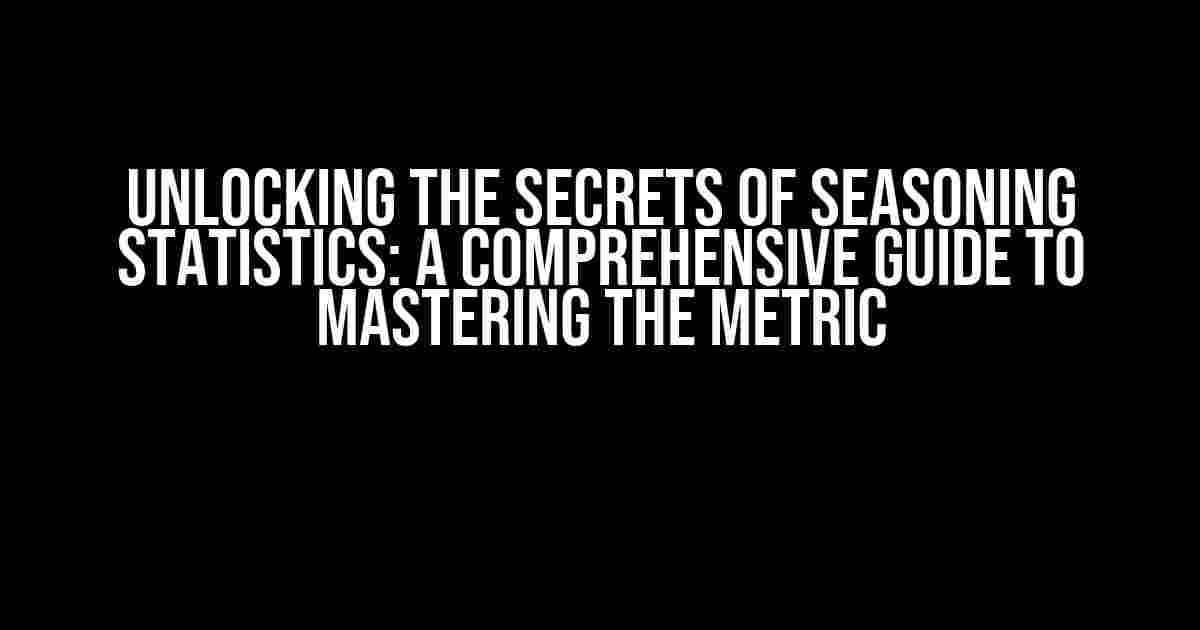Welcome to the world of seasoning statistics, where data meets culinary mastery! In this article, we’ll delve into the fascinating realm of seasoning statistics, exploring the what, why, and how of this crucial metric. Whether you’re a seasoned chef, a data enthusiast, or simply a food lover, this guide will equip you with the knowledge and skills to harness the power of seasoning statistics and take your culinary creations to the next level.
What is Seasoning Statistics?
Seasoning statistics, also known as seasoning analysis, is a method of analyzing the statistical properties of a set of data points, typically related to the measurement of ingredients or cooking techniques in a recipe. This metric helps cooks, chefs, and food scientists understand the underlying patterns and trends in their culinary creations, enabling them to refine recipes, optimize flavor profiles, and predict cooking outcomes.
The Importance of Seasoning Statistics
In today’s fast-paced culinary landscape, seasoning statistics plays a vital role in:
- Recipe development: By analyzing seasoning patterns, chefs can identify areas for improvement and optimize flavor profiles.
- Quality control: Seasoning statistics helps ensure consistency in cooking outcomes, reducing errors and waste.
- Innovation: By uncovering hidden patterns, chefs can create new and exciting flavor combinations.
How to Calculate Seasoning Statistics
Calculating seasoning statistics involves a series of steps:
Collect data: Record measurements of ingredients, cooking techniques, and desired outcomes.Normalize data: Standardize the data to prevent skewed results.Calculate means and medians: Determine the average and median values for each ingredient or technique.Calculate standard deviations: Measure the spread of data points from the mean.Calculate correlations: Identify relationships between ingredients and techniques.
// Example data collection table | Ingredient | Measurement | Cooking Technique | Desired Outcome | | --- | --- | --- | --- | | Salt | 1 tsp | Grilled | Crispy skin | | Pepper | 0.5 tsp | Roasted | Tender meat | | Garlic | 2 cloves | Sauteed | Flavorful sauce |
Interpreting Seasoning Statistics
Once you’ve calculated the seasoning statistics, it’s time to interpret the results:
Identify trends: Look for patterns in the data, such as correlations between ingredients or techniques.Optimize recipes: Use the insights gained to refine recipes and optimize flavor profiles.Predict cooking outcomes: Make informed predictions about the results of future cooking experiments.
| Ingredient | Mean | Median | Standard Deviation |
|---|---|---|---|
| Salt | 1.2 tsp | 1 tsp | 0.5 tsp |
| Pepper | 0.7 tsp | 0.5 tsp | 0.3 tsp |
| Garlic | 2.5 cloves | 2 cloves | 1 clove |
Real-World Applications of Seasoning Statistics
Seasoning statistics has far-reaching implications in various industries:
- Culinary arts: Chefs can create innovative recipes and optimize flavor profiles.
- Food manufacturing: Companies can ensure consistency in mass-produced food products.
- Restaurant management: Managers can optimize menu offerings and reduce food waste.
Common Pitfalls and Challenges
When working with seasoning statistics, be aware of:
Data quality: Ensure accurate and reliable data collection.Data interpretation: Avoid misinterpreting correlations and causality.Over-reliance on statistics: Balance data-driven insights with culinary expertise.
Conclusion
In conclusion, seasoning statistics is a powerful tool in the culinary world, offering insights into the intricate relationships between ingredients, techniques, and desired outcomes. By mastering this metric, cooks, chefs, and food scientists can unlock new possibilities in recipe development, quality control, and innovation. Remember to stay vigilant about data quality, interpretation, and the limits of statistical analysis. With practice and patience, you’ll become a seasoned expert in the art of seasoning statistics.
Happy cooking and data crunching!
Frequently Asked Question
Get to know the ins and outs of seasoning statistics of a metric! Dive into these frequently asked questions and uncover the secrets to making your data shine.
What is seasoning in statistics, and how does it relate to my metrics?
Seasoning in statistics refers to the process of removing seasonal patterns or trends from time series data. This is crucial when analyzing metrics, as it helps to isolate the underlying patterns and trends that aren’t influenced by recurring seasonal factors, like holidays or weather. By seasoning your metrics, you can gain a clearer understanding of what’s driving changes in your data.
How do I know if my metrics need seasoning?
If you notice repetitive patterns in your data that occur at fixed intervals, such as daily, weekly, or yearly cycles, it’s likely that your metrics need seasoning. Other signs include sudden spikes or dips in your data that can be attributed to seasonal events or holidays. By acknowledging these patterns, you can adjust your analysis to focus on the underlying trends and make more accurate predictions.
What are some common methods for seasoning statistics?
There are several methods for seasoning statistics, including time series decomposition, seasonal indexing, and regression analysis. Time series decomposition involves breaking down your data into its trend, seasonal, and residual components. Seasonal indexing involves creating an index that accounts for seasonal patterns, and regression analysis involves modeling the relationship between your data and seasonal factors. The choice of method depends on the nature of your data and the goals of your analysis.
How does seasoning affect my data visualization?
Seasoning can greatly impact your data visualization by providing a more accurate representation of your data. By removing seasonal patterns, you can create more intuitive and informative visualizations that focus on the underlying trends and relationships in your data. This can lead to more effective communication of insights and better decision-making.
Can I use seasoning for metrics other than time series data?
While seasoning is commonly used for time series data, it can also be applied to other types of data that exhibit seasonal patterns, such as spatial data or categorical data. However, the methods and techniques may vary depending on the nature of your data and the goals of your analysis. It’s essential to understand the underlying patterns and relationships in your data to determine the best approach for seasoning.

